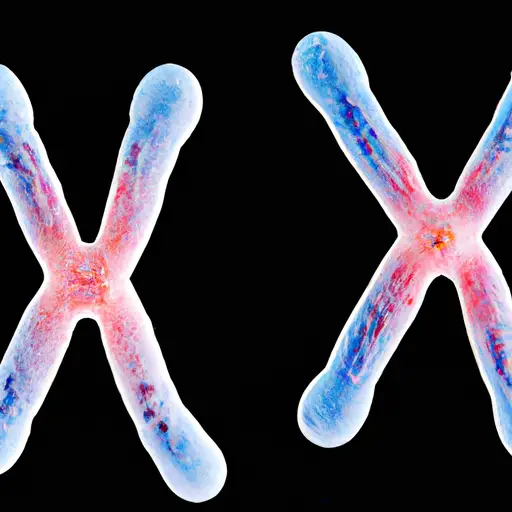So what is the difference between x and y chromosome
1. What are the main differences between X and Y chromosomes?
The X and Y chromosomes are responsible for determining gender in humans. The X chromosome is larger than the Y, and it carries more genetic material. Females have two X chromosomes, whereas males have one X and one Y chromosome. Because the Y chromosome contains fewer genes, it has fewer gene variants than the X chromosome does. Additionally, some of the genes that do exist on the Y chromosome are unique to male development and don’t appear on any other human chromosomal pairings. This means that some diseases or traits can be traced back to a single gene on either an X or a Y chromosome depending on their sex-linked inheritance pattern.
2. How does the presence of X and Y chromosomes determine a person’s gender?
The presence of X and Y chromosomes in a person’s genetic makeup is the primary factor determining their gender. Generally, people with two X chromosomes are female, while those with one X and one Y chromosome are male. This is because the combination of these sex chromosomes carries instructions for human development that differentiate between males and females. Female embryos will develop into women if they possess two X chromosomes, while male embryos require an X and a Y chromosome to reach maturity as men. Furthermore, these sex chromosomes also determine certain physical characteristics such as hair growth patterns or bone structure which further distinguish males from females. Ultimately, it is the presence of an XX or XY combination in a person’s genetic code that determines their gender identity at birth.
3. What genetic material do X and Y chromosomes contain?
The X and Y chromosomes are two sex chromosomes found in humans. The X chromosome contains genetic material which is responsible for the development of female characteristics, while the Y chromosome contains genetic material which is responsible for male traits. These two chromosomes determine an individual’s gender at conception; females typically have XX chromosomes and males typically have XY chromosomes. Both the X and Y contain genes that are responsible for various aspects of human biology, including physical features, reproductive capabilities, eye color and other inherited characteristics.
4. Are there any other types of sex chromosomes besides X and Y?
Yes, there are other types of sex chromosomes in addition to the X and Y chromosomes. In some species, such as fruit flies, there are four different sets of sex chromosomes: XXY, XYY, XYX and XYZ. These combinations can lead to a variety of possible gender outcomes and reproductive strategies for those organisms. Some species even lack any kind of sex chromosome at all! Parthenogenesis is a form of reproduction where offspring are created without fertilization from another organism—and it’s made possible by the absence of any kind of sex chromosome or gamete. To top it off, some individuals have additional copies or mutations in their sex chromosomes which can give them unique characteristics compared to others with more standard chromosomal arrangements.
5. Which chromosome is responsible for producing hormones in males and females?
The Y chromosome is responsible for producing hormones in males and females. This chromosome is one of the two sex chromosomes found in humans, with the other being the X chromosome. The Y chromosome determines male sexual characteristics and plays a role in controlling hormone production during puberty. In females, this chromosomal pair does not have an effect on sexual characteristics or hormone production, as it contains no genes for those purposes. However, it can still be instrumental in determining physical traits such as height and eye color through its genetic contribution to overall human development.
6. What type of mutations can occur on the X or Y chromosome that may cause medical problems?
Mutations on the X or Y chromosome can cause medical conditions related to reproductive health. These mutations are known as sex-linked disorders, since they are linked to the presence or absence of a particular sex chromosome. Examples include Klinefelter Syndrome (XXY), Turner Syndrome (XO) and XYY Syndrome. In addition, some genetic diseases such as Duchenne muscular dystrophy, hemophilia and fragile X syndrome are caused by mutations on the X chromosome. These types of mutations often lead to physical symptoms that may be mild or severe depending on the nature of the mutation and how it affects gene expression in tissues throughout the body. They can also result in cognitive impairments due to changes in brain development; this is especially true for women who have two copies of an altered gene located on their second X chromosome.
7.How do scientists identify which genes are located on each sex chromosome?
Scientists use a variety of techniques to identify which genes are located on each sex chromosome. These include comparing the physical characteristics of individuals with specific genes, such as eye color and hair texture, to determine if they are linked to any particular chromosome. Scientists can also use genetic mapping technologies like polymerase chain reaction (PCR) and sequence-based analysis to compare the DNA sequences in different individuals and pinpoint which chromosomes contain certain genes. Additionally, researchers have developed methods for assessing gene expression patterns across both sexes through RNA sequencing or microarray technologies. By cross-referencing data from all these sources, scientists can accurately identify which genes are present on each sex chromosome.
8.How has the study of sex-specific chromosomes changed over time since their discovery in 1905 ?
Since their discovery in 1905, the study of sex-specific chromosomes has come a long way. For many years, it was assumed that males had an X and Y chromosome while females had two X’s. However, further investigation revealed that this wasn’t always true: some individuals were born with more than two sex chromosomes; others possessed only one. As technology improved and genetic sequencing became increasingly sophisticated, new discoveries were made about the structure and function of these mysterious little packets of DNA. The process of studying sex-specific chromosomes has also evolved over time with modern techniques such as karyotyping becoming commonplace in research labs around the globe. This technique allows scientists to observe a person’s unique set of chromosomes under a microscope which can then be used to accurately diagnose chromosomal abnormalities or even determine gender during prenatal testing procedures. Furthermore, researchers have been able to use these same techniques to uncover novel insights into evolution by comparing different species’ sets of sex-specific chromosomes – something that would have been impossible prior to the invention of modern genetics tools. All this progress means we now understand far more about how these fascinating structures work within our bodies than ever before!
9.Do all species have two distinct sexes determined by their sex chromosomes, or are there some exceptions to this rule?
Not all species have two distinct sexes. In some cases, there are more than two sexes or no sex at all! For example, certain species of fish and reptiles reproduce through asexual reproduction, meaning they do not require two separate sexes to produce offspring. Additionally, some species such as the mangrove rivulus fish exhibit sequential hermaphroditism which means that an individual can change its sex throughout its life cycle. This is done by changing the hormones in their bodies to influence the development of male or female reproductive organs. Certain plants also lack sexual differentiation and instead use other methods for reproducing, such as self-pollination or pollination by wind.
10.Can abnormalities in either the x or y chromosome be inherited from one generation to another ?
Yes, abnormalities in either the x or y chromosome can be inherited from one generation to another. Chromosomal abnormalities are caused by changes in the number of chromosomes or a structural change in one or more chromosomes. They can be passed down from parent to child, but it is not always the case. In some cases, chromosomal abnormalities occur as random events during the formation of eggs and sperm cells. These abnormal cells may then result in embryos with extra or missing chromosomes when they develop into a fetus. Depending on how severe the abnormality is and what type it is, it usually has an effect on development and growth leading to certain physical traits and intellectual disabilities that can be passed down through generations.

